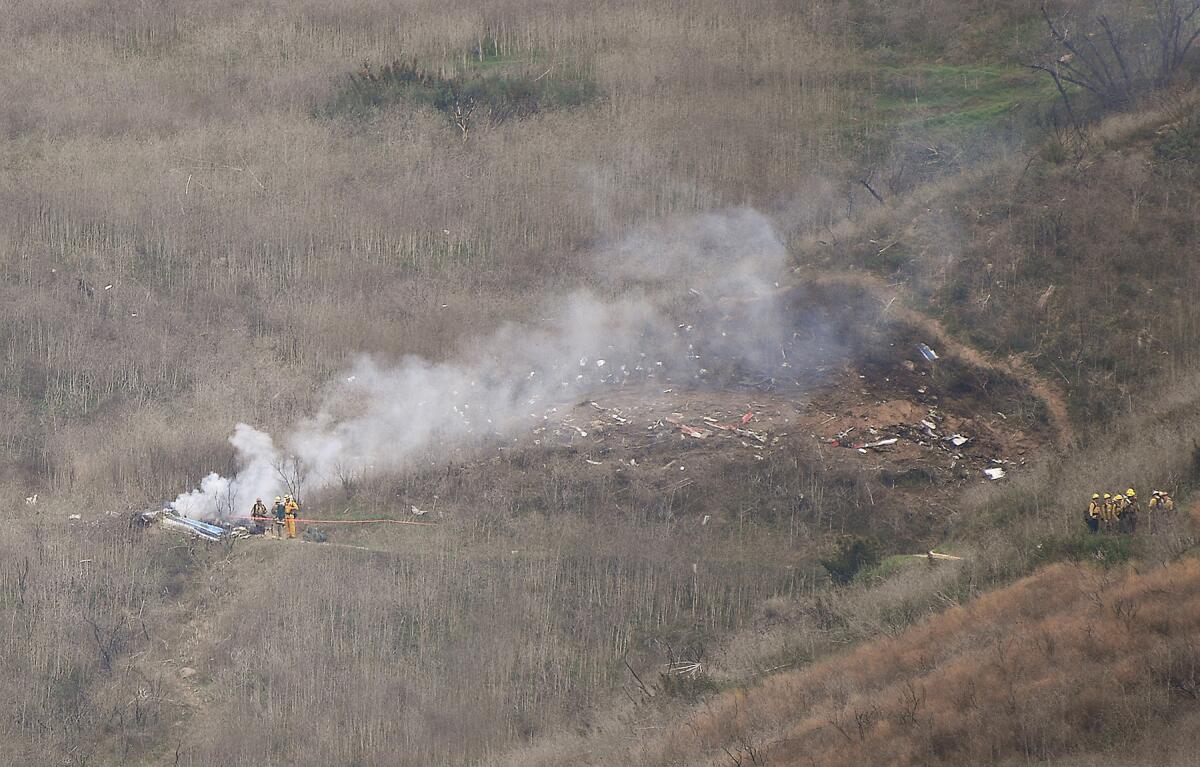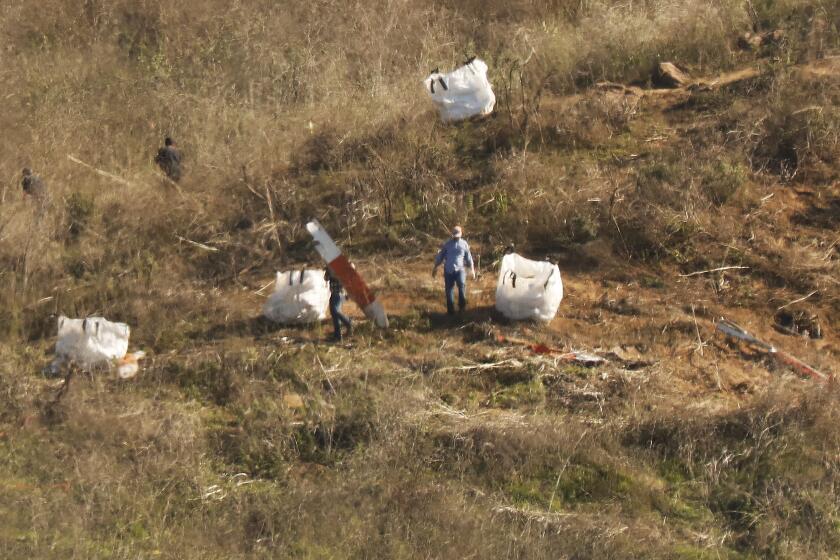Was Kobe Bryant’s pilot disoriented before crash? ‘Spatial-d’ is a big problem in aviation

- Share via
As investigators try to determine the cause of the chopper crash that killed Kobe Bryant and eight others last month, helicopter pilots and aviation experts are pointing to one likely scenario: spatial disorientation.
Spatial disorientation is a common reference in investigation reports of fatal air crashes. Also known as spatial-d, it occurs when a pilot flying in low visibility due to clouds, fog or darkness cannot see a horizon and their senses conflict with the reality of their position.
For the record:
10:31 a.m. Feb. 21, 2020An earlier version of this story misspelled the first name of news chopper pilot Zoey Tur and the last name of Ara Zobayan, the pilot killed in the Kobe Bryant helicopter crash.
It was cited in the crash that killed John F. Kennedy Jr., his wife and her sister as he piloted a plane at night over water off Martha’s Vineyard in 1999. Patsy Cline, Buddy Holly and Jim Reeves all lost their lives in crashes attributed to spatial-d, as did Missouri Gov. Mel Carnahan in 2000.
In 2015, a Louisiana National Guard Black Hawk helicopter crashed off Florida in thick fog, killing 11 after both pilots suffered spatial disorientation.
Federal aviation statistics show it accounts for 5% to 10% of all aviation accidents. When it occurs, it proves deadly 90% of the time.
It will probably take months for the National Transportation Safety Board to determine the cause of the Jan. 26 crash. The pilot of the chopper was struggling with poor visibility in the moments before the aircraft slammed into a Calabasas hillside. Witnesses said fog was dense at the time, and the NTSB released a photo of Bryant’s helicopter flying into clouds shortly before the crash.
Based on those facts, Zoey Tur, a veteran Los Angeles news chopper pilot, said spatial disorientation is a likely cause.
“When you are flying and you cannot see, you don’t know where you are. There are no visual cues, so you are relying on your inner ear. You don’t know [if] up is down or down is up,” she said.
Bryant’s longtime pilot Ara Zobayan, at the controls of the Island Express-owned Sikorsky S-76B chopper, skimmed below the clouds from John Wayne Airport on his way to Camarillo, where a limousine would meet the group of parents, coaches and girls for a game at Bryant’s Mamba Sports Academy in nearby Thousand Oaks.
Zobayan was flying under what are known as visual flight rules, which require pilots to rely on their eyes. As visibility deteriorated, he lingered over Burbank and arranged to fly “special VFR,” under which an air traffic controller tracked him across the San Fernando Valley to the 101 Freeway pass into Calabasas.
The pilot flew so low that the air traffic controller informed him he was unable to keep following the chopper on the radar. As he neared Lost Hills Road, Zobayan told another air traffic controller he was climbing to 4,000 feet to get above the cloud layer. His altitude was 2,300 feet, about 100 feet below the cloud tops.
Eight seconds later, after his last communication, the helicopter forked left in a rapid descent “increasing to over 4,000 feet per minute,” according to a preliminary report from the NTSB that found no mechanical or engine failure. The chopper slammed into the hillside at 184 mph, creating a two-foot-deep crater and splintering wreckage over an area the size of a football field.
Tur said Zobayan, while having 19 years of flying experience, in that final minute was probably not focusing on his instruments.
“The most important instruments are the artificial horizon and your airspeed indicator. And the airspeed indicator is climbing. That means you are going down nose down. The horizon should show the same thing. But he is not relying on the instruments,” Tur explained. “He is relying on the inner ear and he is looking out the window.”
Zobayan was approved to fly solely using instruments, known as instrument flight rules, but the helicopter’s operator was not approved to conduct passenger operations under such rules.
Tur, however, said that when a pilot loses orientation, he or she must completely trust their instruments, “which takes a lot of instrument time.”
The human body is made for the ground, veteran pilots say. A person’s sense of balance comprises vision, an ability to detect movements with muscles and joints, and the inner ear balancing mechanism. Without a horizon to look at, a pilot’s inner ear can be deceived into feeling they are flying straight when they are actually banking or turning, and descent can be perceived as flying level.
Pilots want to reach the destination. And they hope the weather is going to get better somewhere ahead.
The Federal Aviation Administration warns pilots of the threat of spatial disorientation, detailing six ways pilots can be fooled by their bodies. Research at the University of Illinois found that pilots with no instrument training flying into bad weather lasted on average 178 seconds before losing control.
Veteran Sikorsky pilot Doug Solbrekken, who for two decades flew choppers and trained others in British Columbia, Canada, said of the Calabasas crash “that this kind of loss of situational awareness or spatial disorientation” was probably unrecognized by the pilot.
“This is common when pilots have some training in [instrument flight rules] but are not current or have little practical experience.”
The NTSB has released security camera footage that captured the helicopter’s last seconds above Las Virgenes Road. Solbrekken said that video shows a steady, high-speed descent and supports the view that the pilot may have suffered spatial disorientation. He said there is “no reeling, surging or screaming engine sounds of an aircraft in an unusual attitude, straight down or upside down.”
In May 2013, a Sikorsky S-76A crashed in Canada, killing four people on a nighttime medical flight. In that crash, there was what is termed a black hole effect, in which the night sky and ground blur, leaving pilots visually disoriented. As the helicopter climbed 300 feet into the darkness, the first officer commenced a left-hand turn and the crew began carrying out post-takeoff checks. During the turn, the aircraft’s angle of bank increased, and an inadvertent descent began. The captain recognized that the chopper was descending and called for the first officer to initiate a climb, but it was too late and the aircraft hit the ground.
The kind of spatial disorientation suffered by those pilots is similar to the crash that killed Kennedy Jr., his wife, Carolyn Bessette-Kennedy, and her sister Lauren Bessette in July 1999. According to the NTSB, Kennedy, a relatively inexperienced pilot flying visually, failed to control the airplane during a descent over water because of spatial disorientation on a hazy and dark night.
The Piper Saratoga aircraft made several turns, alternately climbing and descending before finally entering an increasingly tight turn with increasing speed and its nose down. The aircraft’s rate of descent reached an estimated 4,700 feet per minute before hitting the water, nose down.
“Spatial disorientation as a result of continued VFR flight into adverse weather conditions is regularly near the top of the cause/factor list in annual statistics on fatal aircraft accidents,” the NTSB report said.
More to Read
Sign up for Essential California
The most important California stories and recommendations in your inbox every morning.
You may occasionally receive promotional content from the Los Angeles Times.












